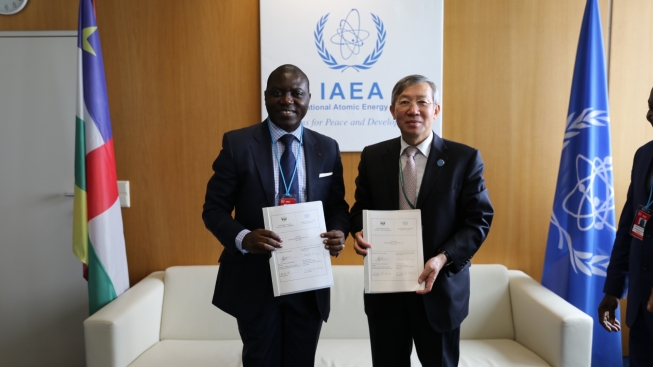(Video: J. Weilguny and M. Klingenboeck/IAEA)
(As prepared for delivery)
Good morning, Excellencies, Ladies and Gentlemen.
I am very pleased to welcome you all to this conference on the IAEA Technical Cooperation Programme.
In this 60th anniversary year of the IAEA, we have been considering
the many lessons we have learned in sharing peaceful nuclear science and
technology with developing countries.
For me, a fundamental lesson is that science and technology are critical for development.
I grew up in Japan after World War Two. My country has limited
natural resources. But by making use of all that modern technology has
to offer, and investing in education, Japan built up its economy.
So I am a great believer in science and technology.
Transferring nuclear technology to developing countries is core IAEA business and one of the most important areas of our work.
The IAEA technical cooperation programme is central to delivery of our Atoms for Peace and Development mandate. It has improved the health and prosperity of millions of people.
We have been working for decades to make nuclear technology available
in areas where it has unique, or added, value. The TC programme now
helps countries to achieve the Sustainable Development Goals, in energy,
food and agriculture, industry and water management, as well as in
health.
I have seen for myself in visits to developing countries all over the
world that TC projects deliver huge benefits to individuals, families
and entire communities.
The fact that we are constantly attracting new Member States
indicates that the TC programme is effective in meeting development
needs.
Central to our approach is the belief that developing countries
should determine their own priorities. They decide in what areas they
wish to benefit from nuclear science and technology. We then do our best
to provide the support they seek.
That support is not primarily about handing over equipment. We focus
on transferring knowledge and expertise. High-quality technical training
helps developing countries to build their own expertise so they can
train future generations of nuclear specialists.
Many developing countries have already acquired a high level of
expertise in nuclear technology and there are many excellent examples of
South-South cooperation. This makes a vital contribution to helping the
Agency deliver its technical cooperation programme.
Ladies and Gentlemen,
Nuclear technology has applications in so many areas of our lives
that it is not possible for me to list all of them. But I will mention a
few examples of areas in which the IAEA is very active.
We have helped to save countless lives in developing countries by
improving access to nuclear medicine and radiotherapy for the diagnosis
and treatment of cancer and other major diseases. Agency support for
Mauritania and Zambia, for example, enabled them to set up their first
nuclear medicine and radiotherapy facilities, bringing essential health
services to millions of people
Nuclear techniques made available by the Agency are being used to
manage water resources, reduce soil erosion, develop new varieties of
rice and wheat that grow in difficult conditions, eradicate insect pests
such as the tsetse fly, and monitor pollution in the sea.
In Europe and central Asia, many countries have been able to improve
the yield and quality of food crops by using nuclear techniques. Viet
Nam has increased rice production.
The IAEA contributed to the eradication of the cattle disease Rinderpest.
After devastating earthquakes in Ecuador and Nepal, we sent experts
in non-destructive testing techniques – including radiography – to
assess the safety of hospitals and schools in danger of collapse.
We demonstrated our ability to respond quickly to emergencies such as
the Ebola and Zika viruses, supplying affected countries with simple
nuclear-derived kits so they could detect the diseases quickly and
accurately in the field.
Partnerships are an essential element of our work.
Together with the Food and Agriculture Organization of the United
Nations, the IAEA deploys nuclear techniques to help increase food
production, manage pollution, reverse land degradation and restore
soils.
We work with the World Health Organization to help improve the
availability of radiotherapy and nuclear medicine. We train health
professionals and sometimes supply equipment for diagnosis and
treatment.
Ladies and Gentlemen,
When the IAEA Statute entered into force in July 1957, the nuclear
world looked very different from the way it does today. Few countries
had access to peaceful nuclear science and technology and there was
little understanding of the potential benefits.
Capacity-building was part of our work right from the start. The first 218 IAEA fellowships were awarded in 1958.
Over the years, as many countries developed some nuclear capacity,
the programme gradually evolved from assistance to cooperation. This was
a very important shift in emphasis.
Since 1958, more than 48,000 scientists and engineers have held
fellowships and scientific visitor positions through the TC programme,
both at the Agency’s laboratories, and in the facilities of our partners
around the world.
Many of these scientists and engineers went on to play a key role in building capacity in nuclear science in their countries.
I am especially pleased to welcome a very distinguished former IAEA
fellow – His Excellency President Tabaré Vázquez of Uruguay – as one of
our speakers this morning.
The IAEA technical cooperation programme is a shared responsibility
of all Member States, made possible by the sustained commitment of all
to the Technical Cooperation Fund, and supplemented by further
contributions by donor countries. Last year, the TC Programme delivered
support to 146 countries and territories, including 37 Least Developed
Countries.
In recent years, we have had more staff funded by our regular budget
to implement technical cooperation activities. This enabled us to
achieve a higher implementation rate for the TC programme.
The Agency’s Peaceful Uses Initiative, launched in 2010, provides
additional funds for our work. It has helped to raise over 100 million
euros for more than 200 projects that benefit around 150 countries.
I am very grateful to all countries which have contributed to the PUI
and I hope to be able to continue with this valuable initiative with
the support of our Member States.
Ladies and Gentlemen,
Energy is indispensable for development. Huge increases in energy
supply will be required in the coming decades to support economic
development and lift some 2.6 billion people out of energy poverty.
Many countries believe nuclear power can help them to address the
twin challenges of ensuring reliable energy supplies, while curbing
greenhouse gas emissions.
Nuclear power is one of the lowest-carbon technologies available to
generate electricity. Nuclear power plants produce virtually no
greenhouse gas emissions or air pollutants during their operation, and
only very low emissions over their entire life cycle.
The use of nuclear power can also help to alleviate concerns about volatile fuel prices and security of supply.
Some 30 countries are already using nuclear power. Another 30 are
considering building their first nuclear power plants, or have started
doing so. Most of these possible newcomers are developing nations.
The IAEA does not attempt to influence countries’ decisions on whether or not to add nuclear power to their energy mix.
But if countries decide to proceed, we provide assistance and
information so they can use nuclear power safely, securely and
sustainably.
Ladies and Gentlemen,
The IAEA is unique within the UN system in having eight nuclear applications laboratories – not far from here, in Seibersdorf.
They assist more than 150 countries in areas such as food and
agriculture, human health and the environment. Many Member States rely
on the laboratories for training, technology transfer and analytical
services. A long-overdue modernisation of the laboratories is underway.
Construction is at an advanced stage on the building that will house
the new Insect Pest Control Laboratory. And work has begun on a second
building, which will be home to three laboratories managed jointly by
the IAEA and FAO.
When completed, the laboratories will offer improved scientific services to our 168 Member States.
I thank the countries whose generous contributions have made this
vital modernisation project possible. I hope that Member States will
continue to provide strong support for further work at Seibersdorf in
the coming years.
Ladies and Gentlemen,
Yesterday, I spoke at a meeting of National Liaison Officers from
IAEA Member States. They help to identify, design, implement and monitor
TC projects and have a key role in ensuring their success.
It is important that each country should think strategically about
the TC support it would like from the Agency. TC proposals should be
aligned with national priorities under the SDGs – although they need not
be strictly limited to the SDGs.
Capable National Liaison Officers make a major contribution to the
success of the TC programme. Ideally, they should not be too junior,
because they might not have enough influence in their country to get
things done. It is also helpful if NLOs remain in their posts for a
reasonable period of time in order to ensure continuity.
Ladies and Gentlemen,
The IAEA strongly encourages women to participate in every aspect of the TC programme.
When I visit Member States, I am struck by the fact that more and
more of the scientists, engineers and medical professionals whom I meet
are women. This is true all over the world.
I am proud that some of these highly skilled women have received
training from the Agency, or held IAEA fellowships. Many are already in
senior positions in their countries.
In 2016, nearly 4,400 women participated directly in the TC
programme, as counterparts, fellows, and scientific visitors, as well as
meeting and training course participants. Many women also served as
international experts and lecturers.
We encourage countries to ensure strong participation by women. At
present, around a third of participants are women and we expect that
proportion to show a steady increase in the coming years. The aim is
equal representation. This helps to build a growing pool of qualified
women for the future.
In the Agency, the proportion of women in senior management positions
is now higher than it has ever been. My intention in the coming years
is to appoint more women to very senior positions.
Ladies and Gentlemen,
The IAEA technical cooperation programme has made a valuable contribution to development in the last six decades.
In some areas, such as nuclear energy, safety and security, we are
the leading international organization. In others, such as human health
and food and agriculture, we play a supporting role – but a very
effective one.
In all areas of our work, our goal is to achieve concrete results
that make a clear difference to the lives of the people we serve.
The IAEA delivers.
I thank you all for attending this important conference to share your
insights and ideas. I am confident that your work in the next few days
will help to strengthen both the IAEA technical cooperation programme
and the Agency’s contribution to sustainable development.
Thank you.

























